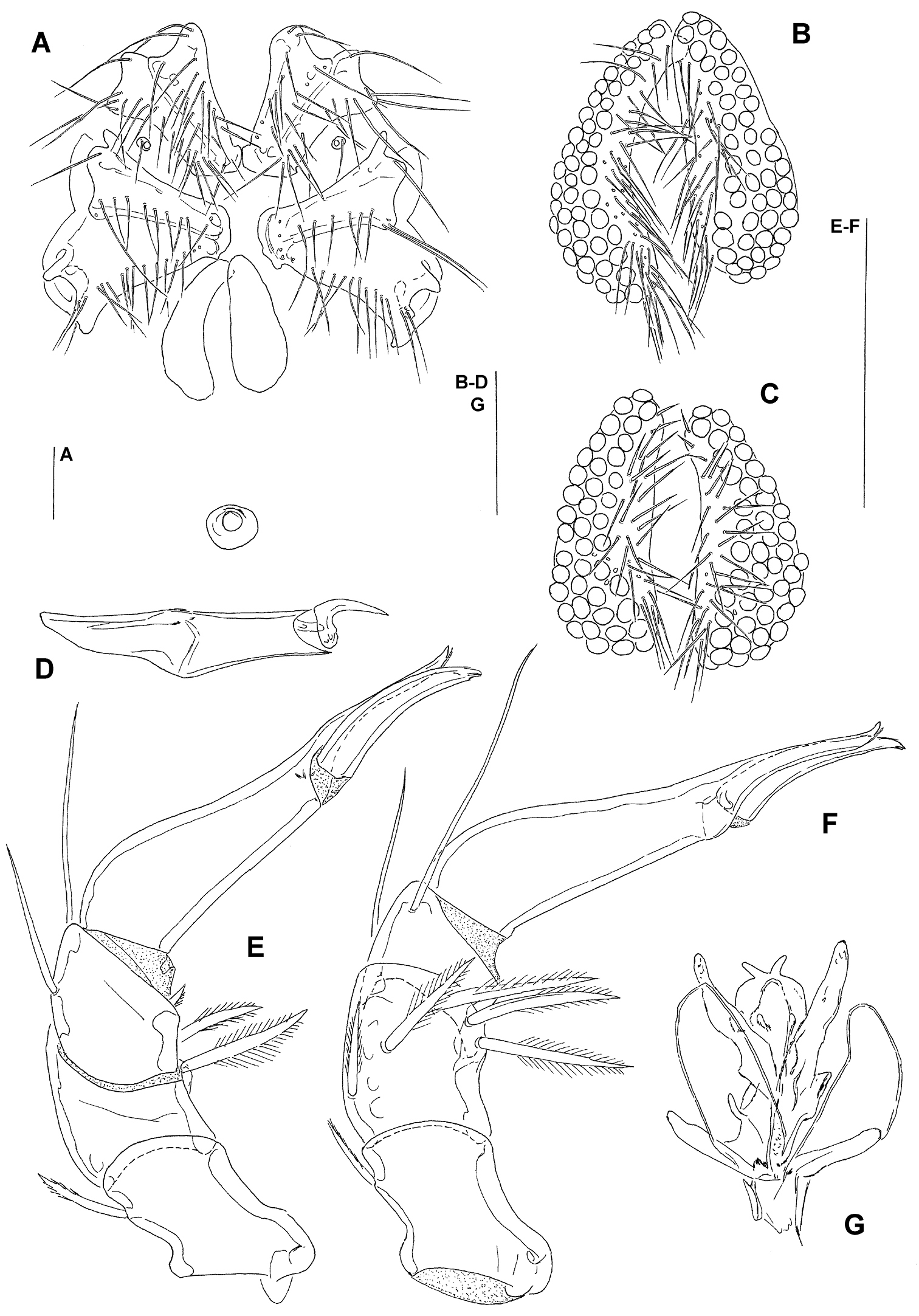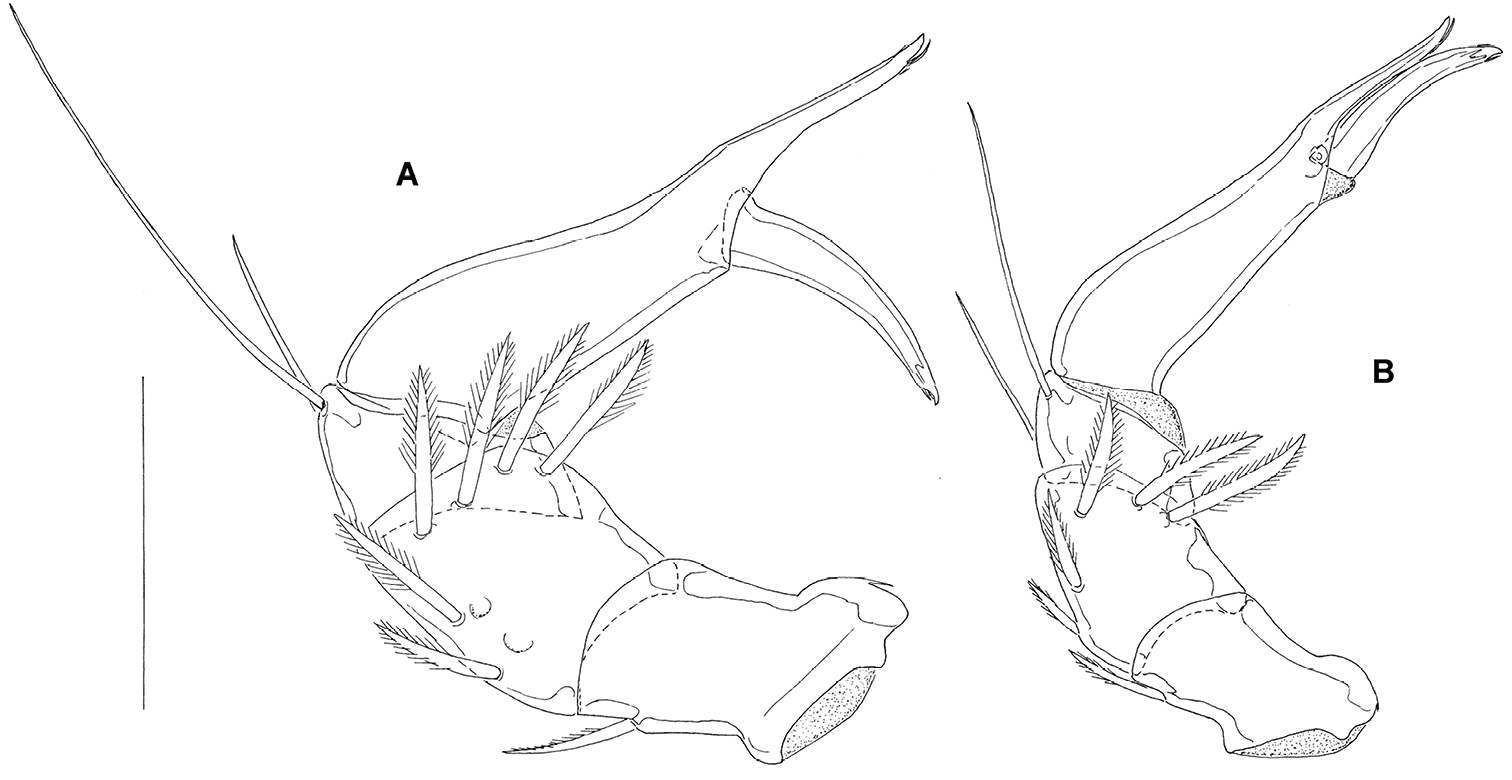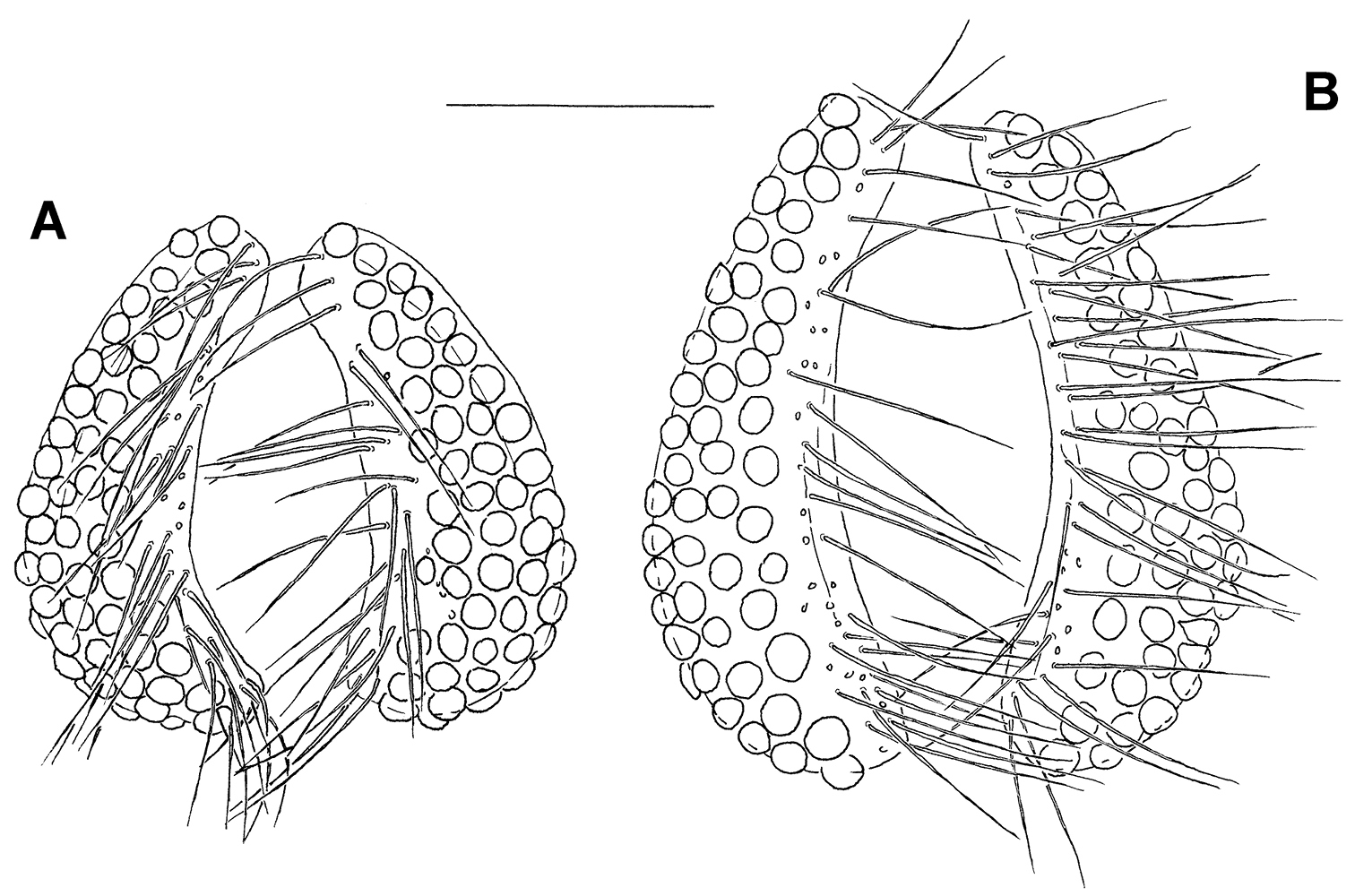






(C) 2011 Vladimir Pešić. This is an open access article distributed under the terms of the Creative Commons Attribution License, which permits unrestricted use, distribution, and reproduction in any medium, provided the original author and source are credited.
For reference, use of the paginated PDF or printed version of this article is recommended.
The genus Hydrodroma Koch, 1837 in Australia consists of six species, the newly described Hydrodroma meridionalis sp. n. included. The new species is described from 45 sampling sites from running waters in Queensland, Victoria, New Southern Wales, Western Australia, Northern Territory and South Australia. Furthermore, a key for the identification of species of Hydrodroma occurring in Australia is given.
water mites, new species, taxonomy
The genus Hydrodroma Koch, 1837has been found in all biogeographic regions except Antarctica. However, the taxonomy and systematics of the genus is difficult (
Recently,
This paper gives the description of a new species and a key for the identification of Hydrodroma species occurring in Australia.
Materials and methodsWater mites were collected by hand netting, sorted on the spot from the living material, preserved in Koenike-fluid and dissected as described by
The composition of the material is given as: males/females/deutonymphs or adults/deutonymphs. All measurements are given in micrometers (µm). The following abbreviations are used: Cx-I = first coxae, dL = dorsal length, H = height, L = length, I/II/III/IV-Leg-1-6 = first to sixth segments of leg I/II/III/IV, IV-Leg-5a = anterior surface of leg IV, segment 5; IV-Leg-5p = posterior surface of leg IV, segment 5; P-1 to P-5 = palp segments 1 to 5, ¯x= mean values, n = number of specimens examined, NP = National Park, vL = ventral length, W = width.
Systematics Hydrodromidae K. Viets, 1936Genus Hydrodroma Koch, 1837
urn:lsid:zoobank.org:act:07CBCA67-AB0B-4191-A7E2-15744527AAE2
http://species-id.net/wiki/Hydrodroma_meridionalis
Figs 1A–G, 2B, 3A; Tables 1–3Holotype male, dissected and slide-mounted, Queensland, Lawn Hill Creek, cascades, Lawn Hill NP, 10.v.2005, 18°41.806S, 138°29.138E (QM). Paratypes: 12 males, 8 females, same data as holotype, one male and one female of them dissected and slide-mounted in Hoyer's fluid (QM); 35/33/0, Lawn Hill Creek at campground, Lawn Hill NP, 10.v.2005, 18°42.011S, 138°29.235E, four males and two females of them dissected and slide-mounted in Hoyer's fluid (RMNH).
QUEENSLAND: Nankin Creek, Rockhampton, 04.v.1981, leg. A.P. Mackey, 2/3/0; ibid., 20.vii.1981, 2 [damaged]/2 [damaged]/0; ibid., 06.ii.1982, 1/1 [damaged] /0; Innot Hot Springs, 11.viii.1989, 1/0/0; Broken River near Conical Pool, Eungella NP, 18.ix.2000, 1/2/0; Crediton Creek, Eungella NP, 18.ix.2000, 2/7/0; The Millstream, upstream of Millstream Falls, Millstream NP, 16.ix.2000, 0/10/0; Wenlock River at crossing with road to Iron Range NP, 06.ix.2000, 1/1/0; Little Yabba Creek, S of Kenilworth, 20.ix.2000, 2/9/0; Cattle Creek at crossing with road to Finch Hatton Gorge, W of Mackay, 19.ix.2000, 0/6/1; Fletcher Creek, Dalrymple NP, 22.x.2005, 19°49.125S, 146°03.771E, 6/7/0; Alligator Creek, Bowling Green Bay NP, 22.x.2005, 19°26.192S, 146°56.862E, alt. 32 m a.s.l., 5/10/0 (0/1/0 mounted); Gregory River at Gregory Downs, 11.x.2005, 8°38.811S; 139°15.008E, alt. 68 m a.s.l., 30/0; Waterview Creek at Jourama Falls, Paluma Range NP, 20.x.2005, 18°51.729S, 146°07.650E, 1/0/0; Davies Creek, Davies Creek NP, 13.x.2005, 17°00.212S, 145°34.180E, 1/2/0; Little Yabba creek at Charlie Moreland Campground, Kenilworth, 02.xi.2005, 26°36.928S, 152°39.105E, 11/15/0. NEW SOUTH WALES: School Creek near Morton NP, 05.xi.2001, 0/1/0; Upper Kangaroo River, N of Kangaroo Valley, 07.xi.2001, 1/1/0; Wattamolla Creek, Royal NP, 08.xi.2001, 0/2/0; tributary of Sawyers Creek, S of Kangaroo Valley, 06.xi.2001, 2/2/0; Bugong Creek near border of Morton NP, 05.xi.2001, 6/9/1; Nymboida River at Platypus Flat, Nymboi-Binderay NP, 09.xi.2003, 30°11.146S, 152°41.499E, alt. 443 m a.s.l., 2/1/0; Urumbilum River, Bindarri NP, 7.xi.2003, 30°15.966S, 152°57.042E, alt. 137 m a.s.l., 3/2/0 (1/0/0 mounted); Mann River at Mann River Nature Reserve, 20.xi.2003, 29°41.291S, 152°05.815E, alt. 403 m a.s.l., 2/2/0 (1/0/0 mounted); Towamba River at Big Jack Rest Area, South East Forests NP, 11.xii.2003, 31°53.885S, 149°27.807E, alt. 271 m a.s.l, 1/6/0; Wog Wog River at crossing with Wog Way, 10.xii.2003, 37°04.986S, 149°29.027E, alt. 332 m a.s.l., 1/0/2; Bellinger River at Gordanville Crossing, 22.xi.2003, 30°25.067S, 152°50.845E, alt. 20 m a.s.l., 1/1/0; Minnemurra River at Minnemurra Rainforest, 18.xii.2003, 34°38.183S, 150°43.272E, 0/2/2; NORTHERN TERRITORY: Douglas River at Douglas Hot Springs, 01.viii.1994, 13°46S, 131°26E, 3/1/0 (1/1/0 mounted); Pond Chinaman Creek, 16 km S of Katherine, 29.vii.1994, 7/7/1; Pool near Jim Jim Falls, Kakadu NP, 23.vii.1994, 2/0/0; Katherine River near Visitors Centre, Katherine Gorge NP, 28.vii.1994, 4/1/0; 17 Mile Creek, tributary of Katherine River, Katherine Gorge NP, 28.vii.1994, 0/2/0. WESTERN AUSTRALIA: Pool Lennard River, Windjana Gorge NP, 09.ix.1998, 1/1/0; Plunge pool, The Grotto, S of Wyndham, 20.ix.1998 1/0/0; Pool Lennard Gorge, The Kimberley, 1.ix.1998, 2/1/0; Pool Valentine Springs, W of Kununurra, 18.ix.1998, 0/2/0; Plunge Pool Black Rock Falls, W of Kununurra, 18.ix.1998, 0/1/0; pools 3 km W of Lennard Gorge, The Kimberley, 10.ix.1998, 1/1/0; unnamed creek at crossing with Windjana Gorge road, 38 km N of Great Northern Highway, 30.ix.1998, 2/9/0; pool west of Tunnel Creek, Tunnel Creek NP, 30.ix.1998, 6/6/0. VICTORIA: Crystal Brooke at Hospice Plain, Mt Buffalo NP, 10.x.1997, 0/1/0; Stony Creek downstream of Turret Falls, Grampians NP, 17.iii.2008, 37°09.662S, 142°29.789E, alt. 517 m a.s.l., 0/1/0; Mt Williams Creek, downstream of Kalymna Falls, Grampians NP, 18.iii.2008, 37°19.034S, 142°36.212E, 1/0/0; Rockpool Buandik Falls, 16.iii.2008, 37°14.803S, 142°16.914E, 1/2/0; Stringers Creek upstream of Walhalla, 09.iii.2008, 37°56.006S, 146°26.926E, alt. 360 m a.s.l., 0/1/0; Jump Creek, Mt Buffalo NP, 11.iii.2008, 36°46.350S, 146°47.636E, alt. 1468 m a.s.l., 1/1/0;. SOUTH AUSTRALIA: Onkaparinga River at Sundews Trail, Onkaparinga NP., 06.iv.2008, 35°09.478S, 138°34.791E, alt. 95 m a.s.l., 5/3/0.
Genital plate with 37–52 acetabula in 3–4 longitudinal rows; palp segments narrow (L/H ratio P-4 4.6–5.2, in both sexes); number of swimming setae: II-Leg-5 1; III-Leg-4p 7–9, III-Leg-5p 5–7, IV-Leg-4a 6–12, IV-Leg-4p 6–12, IV-Leg-5a 2–4, IV-Leg-5p 2–8.
Male. (holotype; in parentheses measurements of paratypes, if not given otherwise n = 5): Idiosoma L/W (800–994/680–813); integument papillae bluntly pointed. Coxal field: L Cx-I+II, 208 (206–226, ¯x = 215), Cx-III+IV, 244 (241–263, ¯x = 252), total number of coxal setae: 15–18 (18–22, ¯x = 20) on Cx-I, 18–19 (16–21, ¯x = 18) on Cx-II, 14 (11–16, ¯x = 14) on Cx-III, 17 (15–19, ¯x = 17) on Cx-IV. Genital plate (Fig. 1B, 3A): setae more numerous than in females, for measurements, Ac and setae numbers see Table 1; ejaculatory complex L 163 (163–177, n = 3, ¯x = 169). Capitulum vL 183 (188–203, ¯x = 195); chelicera (Fig. 1D) total L 247 (265–275, ¯x = 270), basal segment L 194 (209–216, ¯x = 213), claw L 51 (52–55, ¯x = 54). Palp as in female, for chaetotaxy see Fig. 2B, for measurements see Table 1. Number of swimming setae on legs are presented in Table 2.
Female. (paratypes, n = 3): Idiosoma L/W 840–1044/750–938. Coxal field: L Cx-I+II, 219, Cx-III+IV, 247; number of coxal setae: 18–23 (¯x = 21) on Cx-I, 14–23 (¯x = 19) on Cx-II, 12–16 (¯x = 14) on Cx-III, 14–19 (¯x = 17) on Cx-IV. Shape of genital plate as in Fig. 1C, for measurements, Ac and setae numbers see Table 1. Capitulum vL 203–225 (¯x = 217); chelicera total L 269–286 (¯x = 278), basal segment L 214–235 (¯x = 224), claw L 54–60 (¯x = 56). Palp: For chaetotaxy see Fig. 1F, for measurements see Table 1. Numbers of swimming setae on legs are presented in Table 2.
A–G Hydrodroma meridionalis sp.n. (A–B, D, G = male holotype, C, E, F = female paratype) A = coxal and genital field B–C = genital field D = chelicera E = palp, lateral view F = palp, medial view G = ejaculatory complex. Scale Bars = 100 μm.
A Hydrodroma torrenticola (Walter, 1908), male (Croatia, Ombla spring): palp, medial view B Hydrodroma meridionalis sp. n., male holotype: palp, medial view. Scale bar = 100 μm.
A Hydrodroma meridionalis sp. n., male paratype: genital field B Hydrodroma torrenticola (Walter, 1908), male (Serbia, Kozjak Mt., stream): genital field. Scale bar = 100 μm.
Morphometric data for the genital plate, palp and leg segments (2–6) for Hydrodroma meridionalis sp. n. Numbers (n) and length in µm (L) are given.
| MALE | FEMALE | ||
|---|---|---|---|
| holotype | paratype (n =5, in parentheses ¯x) |
paratype (n=3) |
|
| genital acetabula, n | 47–46 | 42–51 (49) | 37–52 (45) |
| genital setae, n | 32–46 | 35–43 (38) | 27–33 (31) |
| genital plate, L | 191–195 | 184–200 (192) | 175–195 (185 ) |
| dL P-1 | 39 | 43–47 (45) | 46–63 (53) |
| dL P-2 | 65 | 63–65 (65) | 64–70 (66 ) |
| dL P-3 | 44 | 35–48(42) | 43–52 (48) |
| dL P-4 | 158 | 163–168 (165) | 168–182 (176) |
| dL P-5 | 67 | 62–67 (66) | 69–72 (70) |
| Palp, total L | 373 | 376–390 (383) | 390–428 (413) |
| H P-4 | 32 | 32–34 (33) | 35–39 (36) |
| L/H P-4 ratio | 4.9 | 4.8–5.1 (5.0) | 4.6–5.2 (4.9) |
| dL I-Leg-2 | 68 | 72–75 (74) | 73–86 (80) |
| dL I-Leg-3 | 94 | 97–100 (99) | 95–109 (103) |
| dL I-Leg-4 | 141 | 143–147 (145) | 144–172 (157) |
| dL I-Leg-5 | 184 | 184–194 (189) | 194–222 (207) |
| dL I-Leg-6 | 172 | 166–184 (179) | 178–194 (189) |
| dL II-Leg-2 | 88 | 91–97 (93) | 97–103 (100) |
| dL II-Leg-3 | 116 | 116–122 (118) | 119–137 (128) |
| dL II-Leg-4 | 191 | 197–203 (201) | 203–234 (220) |
| dL II-Leg-5 | 234 | 238–250 (245) | 244–281 (261) |
| dL II-Leg-6 | 203 | 200–220 (214) | 191–226 (214) |
| dL III-Leg-2 | 91 | 94–103 (98) | 100–116 (109) |
| dL III-Leg-3 | 109 | 111–119 (116) | 115–131 (125) |
| dL III-Leg-4 | 176 | 185–191 (189) | 192–222 (208) |
| dL III-Leg-5 | 219 | 222–234 (229) | 234–267 (249) |
| dL III-Leg-6 | 198 | 191–217 (208) | 210–229 (220) |
| dL IV-Leg-2 | 122 | 128–141 (132) | 134–159 (146) |
| dL IV-Leg-3 | 159 | 159–178 (169) | 175–200 (187) |
| dL IV-Leg-4 | 244 | 244–259 (252) | 259–294 (276) |
| dL IV-Leg-5 | 261 | 259–281 (272) | 281–322 (299) |
| dL IV-Leg-6 | 239 | 231–252 (245) | 255–275 (266) |
Table 2. Number of swimming setae of Hydrodroma meridionalis sp. n., from Lawn Hill Creek (type series).
| Hydrodroma meridionalis sp. n. | ||
|---|---|---|
| male holotype (paratype, n =7) |
female (n = 5) |
|
| II-Leg-5p | 1 (1) | 1 |
| III-Leg-4p | 8 (8–9) | 7–9 |
| III-Leg-5p | 6 (5–7) | 5–7 |
| IV-Leg-4a | 8–9 (8–10) | 9–10 |
| IV-Leg-4p | 8–9 (8–9 ) | 8–10 |
| IV-Leg-5a | 2–3 (2–3) | 1–3 |
| IV-Leg-5p | 4–5 (4–6) | 3–6 |
Number of swimming setae of Hydrodroma meridionalis sp. n. (Victoria: Stony Creek 1♀, Rockpool Buandik Falls 2♀, Jump Creek 1♂; Queensland: Gregory River 2♂, 2♀, Fletcher Creek 3♀, Cattle Creek 1♀, Waterview Creek 1♂, Davies Creek 1♂, 1♀, Alligator Creek 1♀, Broken River 2♀; New South Wales: Kangaroo Valley 1♂, 1♀, Bugong Creek 2♂, 1♀, Towamba River 1♀, Wog Wog River 1♂; Western Australia: Plunge pool, The Grotto, S of Wyndham, 1♂, Pool Lennard River 2♀, 1♂, S of Kununnura 2♀, pool W of Tunnel Creek 2♂, 1♀, unnamed creek at crossing with Windjana Gorge road 1♀; Northern Territory: Douglas River 1♂, 1♀, Chinaman Creek 2♂, 3♀).
| Victoria | Queensland | New Southern Wales | Western Australia | Northern Territory | ||||||
|---|---|---|---|---|---|---|---|---|---|---|
| male (n=1) |
female (n=3) |
male (n=4) |
female (n=10) |
male (n=4) |
female (n=3) |
male (n=4) |
female (n=7) |
male (n=3) |
female (n=4) |
|
| II-Leg-5p | 1 | 1 | 1 | 1 | 1 | 1 | 1 | 1 | 1 | 1 |
| III-Leg-4p | 8 | 9–12 | 8–9 | 8–9 | 8–12 | 10–12 | 7–11 | 6–9 | 8–9 | 7–12 |
| III-Leg-5p | 6 | 6–9 | 6–5 | 4–6 | 7–10 | 8–11 | 3–6 | 3–7 | 5–6 | 5–8 |
| IV-Leg-4a | 8 | 8–12 | 7–10 | 6–11 | 7–10 | 9–11 | 7–9 | 6–9 | 7–8 | 7–9 |
| IV-Leg-4p | 8 | 9–11 | 6–9 | 7–11 | 7–11 | 10–12 | 7–10 | 7–10 | 7–9 | 7–10 |
| IV-Leg-5a | 2 | 3–4 | 2–3 | 1–3 | 2–3 | 3–4 | 0–2 | 1–2 | 2–3 | 0–2 |
| IV-Leg-5p | 5–6 | 7–8 | 3–5 | 3–5 | 4–8 | 5–6 | 4 | 3–4 | 4–5 | 2–6 |
Hydrodroma meridionalis sp. n. is most similar to the European Hydrodroma torrenticola (Walter, 1908), in the presence of one swimming seta on II-Leg-5, IV-Leg-5 anteriorly with 2–5 swimming setae and the presence of relatively large-sized leg claws.
Hydrodroma torrenticola (in parentheses data combined from
We found variability in the number of swimming setae (Table 3). The populations from Western Australia are characterized by generally lower number of swimming setae on anterior IV-Leg-5 (1–2 swimming setae, occasionally setae reduced on one side).
Named for its southern occurrence.
Most specimens were taken from pools of low order streams or from lotic areas of slow flowing streams. Like Hydrodroma torrenticola, the new species is obviously rheophilous.
Widespread in Australia (Queensland, Victoria, New Southern Wales, Western Australia, Northern Territory, South Australia).
| 1 | II-Leg-5 with more than four swimming setae | 2 |
| – | II-Leg-5 with one or without swimming setae | 4 |
| 2 | IV-Leg-5 anteriorly without swimming setae | Hydrodroma kakadu Pešić & Smit, 2007 |
| additional characters: genital plates with 28–47 Ac in 3–4 rows, number of swimming setae: II-Leg-5p 3–8, III-Leg-4 8–10, III-Leg, 5 5–9, IV-Leg-4a, 7–9 IV-Leg-4p 7–9, IV-Leg-5p 3–6 | ||
| – | IV-Leg-5 anteriorly with 2–5 swimming setae; number of Ac and swimming setae various | 3 |
| 3 | Genital plate with < 50 Ac in 3–4 rows | Hydrodroma australis Pešić & Smit, 2007 |
| additional characters: ejaculatory complex L < 210, number of swimming setae: II-Leg-5p 4–6, III-Leg-4 9–14, III-Leg-5 7–10, IV-Leg-4a 7–12, IV-Leg-4p 7–12, IV-Leg-5a 2–4, IV-Leg-5p 4–8 | ||
| – | Genital plate > 70 Ac in 5–6 rows | Hydrodroma kununurra Pešić & Smit, 2007 |
| additional characters: ejaculatory complex L > 210, number of swimming setae: II-Leg-5p 6–9, III-Leg-4 12–19, III-Leg-5 10–12, IV-Leg-4a 11–14, IV-Leg-4p 13–18, IV-Leg-5a 4–6, IV-Leg-5p 9–12 | ||
| 4 | IV-Leg-5 anteriorly with 2–4 swimming setae (usually with two swimming setae, occasionally with a single seta, or setae are reduced on one side; the number of setae should be checked in more specimens) | Hydrodroma meridionalis sp. n. |
| additional characters: genital plates with 37–52 Ac in 3–5 rows, number of swimming setae: III-Leg-4p 7–9, III-Leg-5p 5–7, IV-Leg-4a 6–12, IV-Leg-4p 6–12, IV-Leg-5p 2–8 | ||
| – | IV-Leg-5 anteriorly without swimming setae, number of Ac and swimming setae various | 5 |
| 5 | Genital plate with < 60 Ac in 4–5 rows; legs with a relatively large-sized claw | Hydrodroma wilesi Pešić & Smit, 2007 |
| additional characters: number number of swimming setae: III-Leg-4 1–2, III-Leg-5 1–3 rather short, IV-Leg-4a 2–3, IV-Leg-4p 2–4, IV-Leg-5p 1 | ||
| – | Genital plate with > 110 Ac in 5–9 rows; legs with a relatively small-sized claw | Hydrodroma cooki Pešić & Smit, 2007 |
| additional characters: number of swimming setae: III-Leg-4 > 10, III-Leg-5 7–13, IV-Leg-4a 8–14, IV-Leg-4p 10–16, IV-Leg-5p 6–11 | ||
The junior author is indebted to the national park authorities of Victoria, South Australia, New South Wales, Queensland, Northern Territory and Western Australia for their permission to collect in national parks and nature reserves. Truus van der Pal (Alkmaar) assisted on all collecting trips. Johannes Postma (Ann Arbor) reviewed the English. We are thankful to Dr Andre Bochkov (St.Petersburg), and one anonymous referee for their careful work and valuable comments.


